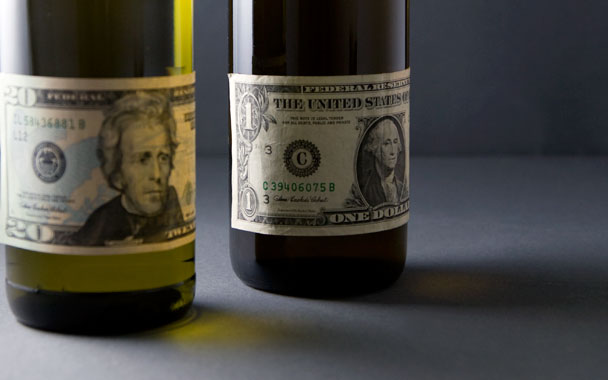If you’re like most people, you don’t have lots of money to spend on finding wines you’ll enjoy. That’s okay. In fact, you’ll probably prefer the less expensive ones anyway. At least that’s the finding of a study Robin Goldstein presented recently at the second annual conference of the American Association of Wine Economists in Portland, Oregon.
The AAWE is a small group of economists from around the world who love wine, and therefore have devised a great many ways to apply their econometric models (and some grant money) to its study. Goldstein, the lead author of “Do More Expensive Wines Taste Better? Evidence from a Large Sample of US Blind Tastings,” is not a working economist, but wrote the paper with two economists from the Stockholm School of Economics and another from Yale. Goldstein is better known as the founder of the Fearless Critic restaurant guides, and, most recently, as the proprietor and sommelier of the award-winning fictitious restaurant L’Osteria Intrepido.
To find out if price correlates to enjoyment when tasters don’t know the cost of a wine, Goldstein chose 523 wines priced from $1.65 to $150. He then organized 17 tastings across the U.S., and gathered 506 volunteers to taste the wines. In each tasting, he had the tasters try six wines at a time, giving them no information about the wines. Without discussing their observations beforehand, the panelists were asked to rate the wines bad, okay, good, or great. Some of the wines appeared twice in the same flight, so the sensitivity of the tasters could be evaluated as well. The scores of those who rated the same wine wildly differently each time were weighed less heavily than those of consistent tasters.
After tabulating all the scores and applying multiple economic models to the results, they determined that regular people—that is, those who don’t have formal wine training (or the practical equivalent)—more often prefer less expensive wines to pricier ones. (This did not hold true for experts.)
Goldstein has many ideas as to why this might be—some more charitable towards wineries and wine critics than others. But even setting aside his suspicions, the results seem logical. Wineries that make more than one bottling of a certain kind of wine tend to make one that’s designed for everyday drinking, and another that’s going to last a long time; it’s meant to be aged. Made with the winery’s best, most concentrated grapes, these wines tend to have tannins that stick your tongue to the roof of your mouth, acidity that feels like razors, and other characteristics that many people find jarring. If you’ve had the experience of such a wine mellowing out over time and turning into something beautiful, such a wine might excite you. Or you may have gotten used to drinking wines like this and have come to like the assault on the taste buds.
But most people haven’t done either, so it doesn’t seem too crazy that they might rather drink something that is immediately pleasant. More affordable bottlings are supposed to be more enjoyable right out of the gate, and by a wide range of people—which is why they are priced within reach of normal wine drinkers.
The issue, of course, is that we’ve been trained to think that price equals quality—or at least denotes prestige. Ask any sommelier and they’ll tell you how hard it is to sell the cheaper wines on their wine list. I’ve known sommeliers who bumped up the price $10 on a favorite affordable bottling that wasn’t moving, then watched it fly off the list. While the wine geeks might be psyched about some $25 find on the list, less-assured wine drinkers may feel safer spending an extra Jackson, regardless of how much the sommelier loves the cheaper bottle.
The fact that wine ratings tend to scale up with price underlines this relationship, but also exposes the great problem with ratings: A numerical score doesn’t tell you how the wine tastes, how it’s made, or how it’s meant to be enjoyed. That’s what the tasting note is theoretically for. Even that’s useless, however, unless you and the critic have similar taste.
Where does this leave you? With nothing but your own taste buds—and if you’ve got the guts to trust them, a fatter wallet.



 Pinterest
Pinterest


